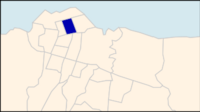Kinshasa (commune)
|
Kinshasa Commune de Kinshasa |
|
|---|---|
| Commune | |
 Commune on a map of Kinshasa (city-province) |
|
 Kinshasa on a map of the DRC |
|
| Coordinates: 04°19′24″S 15°18′29″E / 4.32333°S 15.30806°ECoordinates: 04°19′24″S 15°18′29″E / 4.32333°S 15.30806°E | |
| Country | Democratic Republic of the Congo |
| Province | Kinshasa |
| District | mont ngafula |
| Area | |
| • Total | 2.87 km2 (1.11 sq mi) |
| Population (2004 est.) | |
| • Total | 164,857 |
| • Density | 57,000/km2 (150,000/sq mi) |
Kinshasa is a municipality (commune) in the Lukunga district of the city of Kinshasa, the capital of the Democratic Republic of the Congo. It is situated in the east of the city, south of Gombe and the Boulevard du 30 Juin.
Founded and inhabited by the Teke people or Humbu people, the fishing village of Kinshassa, also spelled Kinchassa, was located at the river Congo before the arrival of the European colonialists. The word nshasa translates as "marsh". Henry Morton Stanley founded the station next to it after signing a treaty with the Teke chief Ntsuvila in the later half of the 19th century. It was linked by steam boat with other stations along the river and the Stanley Pool. With the foundation and expansion of neighbouring Léopoldville Station, the place became with Barumbu and Lingwala part of the city in the beginning of the 20th century.
In the 1940s it became linked to the historic heart of Léopoldville, now located at Kintambo, from the boulevard du 30‑Juin. With the Africanization program initiated by President Mobutu in 1966, the name of the entire city was changed into Kinshasa, based on this original village.
The district is now home to several institutions of the city of Kinshasa, such as the Grand Market of Kinshasa, the Somba Zikita Market, and the zoological garden.
...
Wikipedia
